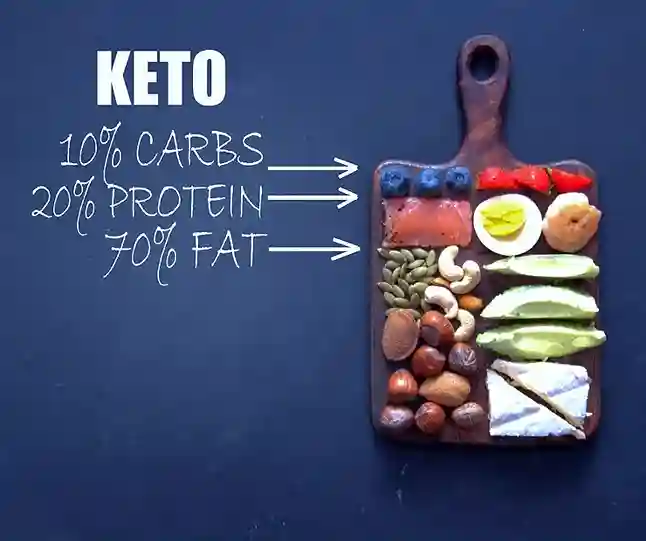We always say that we should feel confident in our own skin, but what if this statement prevents us from facing reality? The reality is that the weight you are trying to fit in is the reason for numerous diseases. Yes, obesity or overweight is a real problem that has tripled from 1975 to 2016 worldwide [1]. According to recent data from the World Obesity Federation, one billion people are estimated to live in obesity by 2030 [2].
Nevertheless, with rising problems, we always try to find the solution, and we end of searching for What is the Ketogenic diet? and one of the popular solutions for obesity is the ketogenic diet, also known as “keto” or “Flat belly diet,” or “metabolism reset diet.” The tagline for the ketogenic diet is “eat fat to lose fat.” In this article, we will find out how far we can lose weight by eating fat in contrast to the age-old practice of avoiding fats to be healthy. What are the Pros and cons of following the keto diet?

Table of Contents
What is the ketogenic diet?
In the ketogenic diet, you restrict your carbohydrate intake to 5-10% and eat 70-80% fat and 10-20% protein. This keto diet was introduced in 1920 as the treatment of epilepsy and, later, tested for different diseases like diabetes, polycystic ovary syndrome, and Alzheimer’s disease [3, 4, 5].
Nonetheless, this keto diet has gained immense popularity as a flat-belly diet, i.e., as a potential weight loss strategy. This keto flat belly diet is similar to the low-carb Atkins diet, whose craze started in the 1970s [3,5]. At the same time, it is distinct from other low-carb diets like Atkins, Paleo, South Bench, and Dukan diets because of its high-fat content of 70-80% inclusion [3,5].
How does the ketogenic diet work for weight loss?
The bases for the ketogenic diet as an efficient weight loss tool is when you follow this diet; the body starts starving for carbohydrates since glucose is the primary source of energy for cells which is restricted very low amount.

Thus, as an alternative source of fuel, the liver produces ketones from stored fat that the brain can use to make energy, hence the keto diet.
Since these ketone bodies are produced using stored fat, they start depleting, and you lose weight [3].
This keto flat belly diet is similar to the low-carb Atkins diet, whose craze started in the 1970s [3].
Different types of Ketogenic diets.
The classic ketogenic diet (KD)
Dr. Russel Wilder initially designed this classic ketogenic diet in 1923 to treat epilepsy in children whose medication was ineffective. The diet considered the 4:1 ratio of fat to protein and carbohydrate as the golden standard, where 90% of calories come from fat, 6% from protein, and 4% from carbohydrates [4,5].
Medium-chain triglyceride (MCT) keto diet.
MCT is the variant of a classic ketogenic diet in which medium-chain triglyceride oil is used as a supplement that is easy to digest as compared to long-chain triglycerides (LCT). Some research has also reported that consumption of MCT rich diet results in a higher level of energy expenditure and fat oxidation thus, greater loss in adipose tissue in contrast to long-chain triglycerides [4,6,7]. The diet can follow any ratio based on a 4:1 ratio “10% LCT fat, 60% MCT fat, 20% carbohydrate, 6% protein” [4].
MCTs diet is profoundly used for weight loss, appetite control, extra energy for exercise, and inflammation. Mainly the MCT oils are made up of coconut or palm kernel oil or a mixture of both [6].
Modified Atkins diet (MAD)
The diet is modified, or different from the Atkins diet as it is less restrictive since it allows for less carbohydrates, and unlimited protein & fat intake than the classic Atkins diet (15 to 20 g/day). Hence the name Modified Atkins diet [8]. The MAD follows an approximately 1.1:1 ratio, “65% fat, 10% carbohydrate, 25% protein” with greater flexibility to adjust meals to variations in appetite [4].
Low glycemic index treatment (LGIT)
The Glycemic index is the representation of a relative rise in blood glucose after the intake of foods having the standard amount of carbohydrates. While foods containing a high Glycemic index potentially lead to diabetes and obesity in contrast foods with a low glycemic index proved to be a promising alternative for the treatment of obesity in children [9]. The non-starchy fruits and vegetables are generally low in glycemic index. This diet format of the ketogenic diet takes into consideration a ratio of 0.6:1 i.e., 60% fat, 10% carbohydrate, and 30% protein [4].
Although the ketogenic diet is divided into different categories, the standard and high protein ketogenic diets are studied extensively.
Side-effects of the ketogenic diet.
When you opt for the ketogenic diet, you start starving your body for carbohydrates; your insulin level drops due to transient reduction of glucose; thus, initially between 1 and 4 days of a fast or ‘keto induction’ leads to several symptoms like muscle cramps, headache, general weakness.
Whereas reduction in food volume intake and increased fat intake, or reduced fibre intake causes constipation, halitosis, diarrhea, general weakness, and rash [10]. Moreover, most of the symptoms get better after 1 to 4 days. [11]
Pros of the ketogenic diet.
Although the ketogenic diet was established for the treatment of various diseases like pediatric pharmaco-resistant epilepsy, it is profoundly used by patients of obesity to lose weight. The variations in diet also help people to fit in their style of the plan from a wide range from classic keto diet to low glycemic index treatment diets.
Other than weight loss studies on women with type 2 diabetes undertaking a ketogenic diet for 90 days revealed that a significant level of reduction of hemoglobin A1C (measures long-term blood sugar management) was observed [12].
The origin of the ketogenic diet was to treat epilepsy; in other words, as a tool to treat diseases. In addition to epilepsy, the keto diet can be used for the treatment of several other diseases like heart disease, cancer, Alzheimer’s disease, Parkinson’s disease, and polycystic ovary [13, 14, 15, 16].

Conclusion
According to several research and the history of the ketogenic diet, it was formulated as a tool for the treatment, and the same was proven since it is used during the treatment of numerous chronic diseases. Despite the keto diet’s efficiency in the treatment of disease, it is highly recommended and exploited for its property of causing weight loss in obese or overweight people.
Frequently asked question
1- What is the ketogenic diet food list?
Fish, shellfish, meat, poultry, yogurt, cream, cheese, unsweetened plant-based milk, and vegetables are the type of foods generally considered keto-friendly. Mainly fruits, grains, and vegetables high in carbohydrates or with high glycemic index are restricted from consumption while following a ketogenic diet.
2- Can the ketogenic diet be used for weight loss?
Yes, since you consume a very low-carbohydrate diet and high fat and protein during the ketogenic diet, which keeps you fuller for longer. Even with the keto induction and reduction of carbohydrates, ketone bodies are produced using stored fat, they start depleting, and you lose weight.
3- Is the ketogenic diet safe for weight loss?
According to studies, the beneficial effects of reducing the patient’s body weight and body mass index with a long-term ketogenic diet were observed.
4- How many calories are prescribed for females?
Although the ketogenic diet doesn’t specify any rules for calories, nutritionists might suggest restricting the intake between 1500 to 1800 calories per day.




